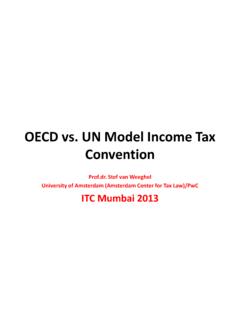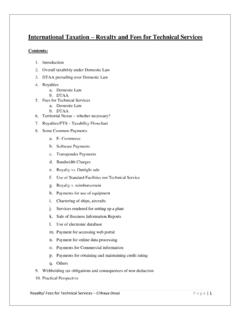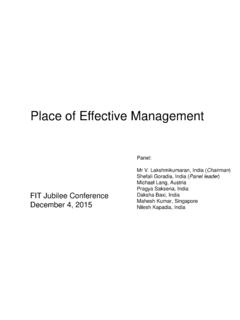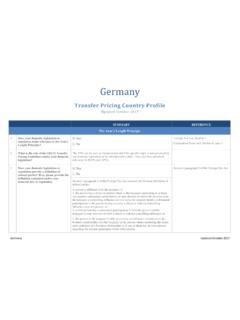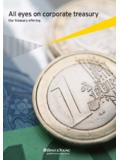Transcription of Article 7 New OECD Rules for Profit Attribution of ...
1 Organisation for Economic Co-operation and DevelopmentCentre for Tax Policy and AdministrationMary BennettHead of Tax Treaty, transfer pricing & Financial Transactions DivisionOECD Centre for Tax Policy and AdministrationArticle 7 New OECD Rules for Profit Attribution of Permanent EstablishmentsInternational Taxation Conference 2010 MumbaiDecember 4, 2010 Mary C. BennettHead of Tax Treaty & transfer pricing DivisionOECD Centre for Tax Policy & Administration2 Overview of presentation Background of PE Profit Attribution project The authorised OECD approach (AOA) Implementation of the AOA.
2 The Council Recommendation The 2008 Commentary changes The new Article 7 Issues in drafting the new Article 7 2010 version of the Report on the Attribution of profits 2 Organisation for Economic Co-operation and DevelopmentCentre for Tax Policy and AdministrationBackground of PE Profit Attribution Project44 Background of PE Profit Attribution Project Project began 1998 to reach a consensus on interpretation of Article 7 Goal to greatest extent possible, to treat a PE as a hypothetical distinct and separate enterprise, and to attribute profits to it in accordance with the arm s length principle.
3 Applying the OECD transfer pricing Guidelines by analogy55 Background of PE Profit Attribution Project The pre-2008 Model Commentary to Article 7 was largely based on the view of the arm s length principle found in the 1979 transfer pricing Report Thinking on the application of the arm s length principle has evolved as reflected in the 1995 OECD transfer pricing Guidelines And considerable experience has been gained since 1995 Organisation for Economic Co-operation and DevelopmentCentre for Tax Policy and AdministrationThe Authorised OECD Approach (AOA)7 Introduction of the AOA Report was finalised in July 2008 and has four inter-related Parts.
4 Part I General Principles Part II Banking Part III Global Trading Part IV Insurance All follow functionally separate entity approach Builds on previous work (1994 update to Article 7 Commentary)78 Two-Step Analysis of Authorised OECD Approach (AOA) Step One Determine the activities and conditions of the hypothetical distinct and separate enterprise , engaged in same or similar activities under same or similar conditions , and dealing wholly independently with the enterprise of which it is a part ( , describe the PE)89 Step One: Hypothesising the PEHow to do Step One: By applying the principles of the OECD s 1995 transfer pricing Guidelines by analogyto perform a factual and functional analysis.
5 To identify functions performed, assets used, and risks assumed by the PE, to attribute adequate free capital to the PE in light of its risks, and to identify any dealings between PE and rest of enterprise910 Step One: Hypothesising the PE Attributing assets and risks to the PE Since legal ownership belongs to the enterprise as a whole, the AOA attributes economic ownership to parts of the enterprise by reference to people functions Similarly, since risk legally belongs to the enterprise as a whole, the AOA determines which part of the enterprise has assumed the risk by reference to people functions1011 Step One: Hypothesising the PE Recognition of dealings between PE and rest of enterprise.
6 Per Part I, a dealing is a real and identifiable event ( the physical transfer of stock in trade, the provision of services, use of an intangible asset, a change in which part of the enterprise is using a capital asset, the transfer of a financial asset, etc.) Taxpayer s internal documentation potentially useful in establishing and characterising dealings1112 Step Two: Determining PE s profits Step Two Determine the profits of the hypothetical separate enterprise by applying the OECD s 1995 transfer pricing Guidelines by analogyto dealings between PE and other parts of the enterprise1213 Implications of the AOA The 2008 Report goes further than before in the recognition of intra-enterprise dealings and in the analogy with a subsidiary This raises difficult questions as regards source taxation of notional payments analogous to rents/interest the Attribution
7 Of free capital to PE relief of double taxation13 Organisation for Economic Co-operation and DevelopmentCentre for Tax Policy and AdministrationImplementation of the AOA15 The Implementation Challenge How to deal with fact that the 2008 Report, unconstrained by prior practice, was more rigorous in applying arm s length principle than some aspects of pre-2008 Commentary? For example, potentially some greater possibility of: Internal royalties Arm s length compensation of internal services Internal loans outside financial sector1516 Implementing the AOA Implementation package designed to reflect a two-track approach.
8 Prepare amended Commentary for existing Model Article 7, importing as much as possible of AOA as does not conflict with existing Commentary to provide certainty for existing treaties Implement full AOA through new text for Article 7of Model, with new Commentary to provide certainty for future treaties1617 Council Recommendation OECD Council Recommendation of 17 July 2008: Political commitment of Member countries to follow 2008 Report in applying treaties based on old Article 7 to the extent Report s conclusions do not conflict with 2008 Commentary Instruction to CFA to prepare a new Article 7 for inclusion in 2010 update to Model to allow for full implementation of AOA in future treaties1718 First phase of implementation Revised Commentary on existing Article 7 published as part of 2008 Update to OECD MTC.
9 Rejection of the relevant business activity approach AOA 2-step approach as basis for adjusting the taxpayer s accounts to an arm s length result ( 17-18) Documentation encouraged ( 20) Guidance for dependent agent PEs ( 26) Guidance for construction PEs ( 23-25) Approaches for the Attribution of capital ( 45-46)1819 Second phase of implementation Drafting text of new Article 7 with accompanying Commentary First draft released July 2008 Public consultation held September 2009 Second draft released November 2009 Final version included in 2010 Update to OECD Model, issued in July19 Organisation for Economic Co-operation and DevelopmentCentre for Tax Policy and AdministrationIssues in Drafting the New Article 721 The new Article 7 Existing Article 7: seven paragraphs New Article 7.
10 One paragraph stays the same Two paragraphs are slightly amended Four paragraphs are deleted One new paragraph (on relief of double taxation)2122 Paragraph 12223 Paragraph 22324 Paragraph 2 (cont.)2425 Deleted paragraphs Old 7(3) (deductibility of expenses incurred for the PE) Old 7(4) (use of apportionment method) Old 7(5) (no Attribution of profits to purchasing function) Old 7(6) (required use of same method year by year) Old 7(7) remains the same (as new 7(4)): Where profits include items of income which are dealt with separately in other Articles of this Convention, then the provisions of those Articles shall not be affected by the provisions of this Article .

